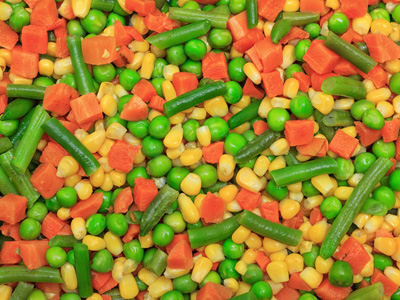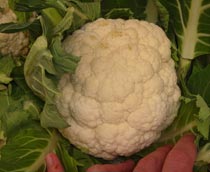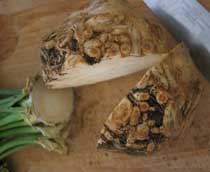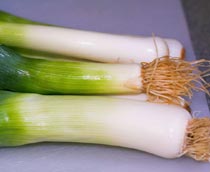
Some vegetables are very brightly-coloured!
Vegetables - Vegetables 3
Can you tell the difference between a turnip and a swede? Are potatoes and sweet potatoes related? How do you prevent club root? Extend your knowledge about vegetable gardening by playing this enjoyable quiz.
Clicking any of the images will expand the pictures and allow you a closer look.
1 .
What is the name given to the premature formation of a cauliflower curd when conditions are unfavourable to growth?
Buttoning
Darning
Sewing
Stitching
- Latin Name: Brassica oleracea.
- Cauliflowers like good rich loam - if you haven't got it then it is maybe best to give them a miss!
- They require plenty of nitrogen.
- Prolonged dry spells without irrigation will ruin your chances of a satisfactory crop.
- They are subject to attack by a myriad of pests and diseases including slugs, cabbage root fly, caterpillars and clubroot.
2 .
Which of the names below is NOT a variety of carrot?
Amsterdam Forcing
Autumn King
Chantenay Red-Cored
Lincolnshire
- Latin Name: Daucus carota.
- England's second favourite vegetable (after potatoes).
- It is an old wives tale that eating large amounts of carrot will make you see in the dark.
- Eating excessive quantities of carrots can make your skin turn orange!
- Covering with fleece protects against carrot fly.
- Grow some of the extra sweet varieties in tubs for summer salads.
3 .
How closely related are the sweet potato (seen here) and the more usual potato grown in the UK?
Different varieties of the same plant
Closely related
Distantly related
Not related
- Latin Name: Ipomoea batatas.
- Needs a good deal of warmth and ample water to grow well in the UK.
- Sometimes grown in greenhouses but worth a try outside in warm, sheltered situations.
- Cannot be grown from seed - they need to be propagated by cuttings or 'slips' that grow from the tubers during storage.
- In tropical areas the sweet potato is often the staple food.
4 .
To get the best crop of celeriac how far apart should the plants be spaced?
3 cm
10 cm
30 cm
100 cm
- Latin Name: Apium graveolens rapaceum.
- Sometimes called celery root, knob celery or turnip-rooted celery.
- It tastes better than it looks!
- Outer surface needs to be chopped off with a sharp knife - it is too tough to peel.
- Sow seeds inside in March and plant outside in May.
- Harvest from September onwards. Leave in the soil until required and protect with a covering of straw if sharp frosts are threatened.
5 .
Sweet corn is a variety of what?
Barley
Maize
Oats
Wheat
- Latin Name: Zea mays var. saccharata.
- Sweet corn is picked and eaten when it is immature, before the seeds start to harden.
- It is ready for cropping when seeds exude a milky fluid when squeezed between the fingers. Too early and the liquid is clear; too late and no liquid can be squeezed out.
- Usually sown inside (glasshouse or windowsill) pricked out into individual pots and then planted out when danger of frost is past.
6 .
The picture below is of spinach. What is the name of a similar vegetable that it is often confused with it?
Cabbage
Celeriac
Chard
Chickpea
- Latin Name: Spinacea oleracea.
- Sow in the spring for picking during the summer or sow in the autumn for cropping in late winter and spring.
- Cut leaves from the outside of the plant leaving the younger leaves in the centre to grow on.
- The dark green leaves and bright red stems make a striking contrast and do not look amiss in a flower border.
7 .
What type of vegetable is this?
Jerusalem Artichoke
Parsnip
Swede
Turnip
- Latin Name: Brassica rapa.
- Varieties that produce large roots are often grown for feeding to livestock.
- Smaller, sweeter varieties (usually white) are grown for human consumption.
- In Japan they are sometimes pickled and even stir fried!
- Crops grow extremely quickly and are sometimes ready to eat within 6 weeks of sowing.
8 .
The leek is the national symbol of which country?
England
Ireland
Scotland
Wales
- Latin Name: Allium ampeloprasum.
- Easy to grow from seed and well worth growing as a source of fresh vegetables throughout the winter months.
- Lift only as many as you require at any one time - they keep better in the soil and will happily withstand quite severe frosts.
- Termed a 'hungry' crop because they require plenty of fertilizer.
- When boiled, leeks become soft and the taste becomes milder.
9 .
What type of cabbage is this?
Dorchester
Ritz
Savoy
Waldorf
- The leaves of this cabbage are more crinkled than other cabbages.
- Amongst the hardiest of all winter vegetables.
- Excessive nitrogen in the soil will make the leaves softer and less likely to withstand severe frosts.
- Can also be grown as a summer vegetable.
- When cooked the leaves tend to go less watery than other cabbages - they stay 'crunchy' and because of this they are preferred by many people.
10 .
Clubroot in Brussels sprouts is best avoided by what means?
Adding lime to the soil
Adding extra fertilizer
Drying out the roots
Regular spraying
- Sprouts prefer heavy soil over light soil.
- They prefer alkali soils over acid soils.
- If possible dig in well-rotted manure before planting.
- Always pick before the individual sprouts start to 'open'.
- When cooking, make a cross with a sharp knife in the bottom of each sprout to ensure that they cook through evenly.
**Unlimited Quizzes Await You! 🚀**
Hey there, quiz champ! 🌟 You've already tackled today's free questions.
Ready for more?
Ready for more?
🔓 Unlock UNLIMITED Quizzes and challenge yourself every day. But that's
not all...
not all...
🔥 As a Subscriber you can join our thrilling "Daily Streak" against other
quizzers. Try to win a coveted spot on our Hall of Fame Page.
quizzers. Try to win a coveted spot on our Hall of Fame Page.
Don't miss out! Join us now and keep the fun rolling. 🎉
**Unlimited Quizzes Await You! 🚀**
Hey there, quiz champ! 🌟 You've already tackled today's free questions. Ready for more?
🔓 Unlock UNLIMITED Quizzes and challenge yourself every day. But that's not all...
🔥 As a Subscriber you can join our thrilling "Daily Streak" against other quizzers. Try to win a coveted spot on our Hall of Fame Page.
Don't miss out! Join us now and keep the fun rolling. 🎉

















